In This Issue
The opinions, beliefs and viewpoints expressed in this publication are those of the authors. They do not necessarily reflect the opinions, beliefs, viewpoints or official policies of Autism Society Alberta.
|
|
|
End article-->
Autism Alberta's Family Resource Centres
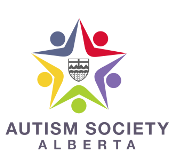
Click below to view the full sized poster
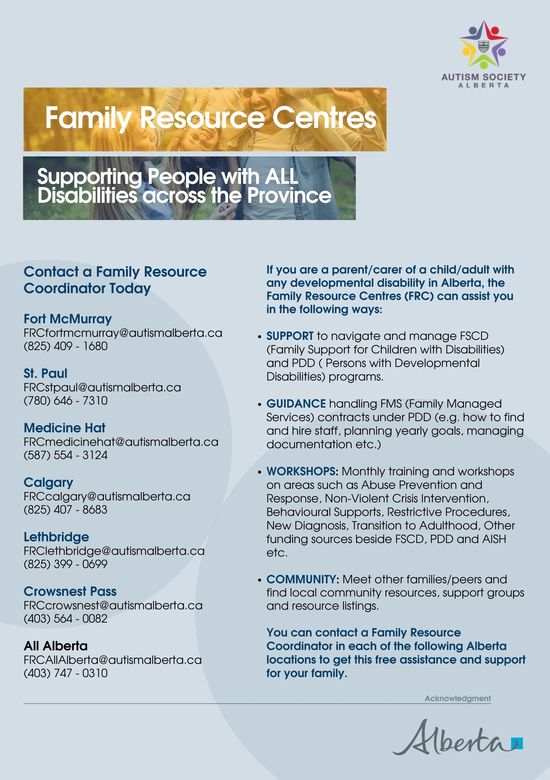
|
|
|
End article-->
Save the Date –
Autism Society Alberta's AGM
and Resource Fair

Join us for
Autism Society Alberta's
2021 Virtual AGM and Resource Fair
Thursday, October 14th
4:00 - 8:00pm MDT
 At our Virtual Resource Fair, we will be hosting a variety of presentations. From learning about how to navigate Family Support for Children with Disabilities (FSCD) and Persons with Developmental Disabilities (PDD) programs, to finding out about the exciting workshops our new Family Resource Centres offer, members will have the opportunity to meet other families and peers, and join the conversation! At our Virtual Resource Fair, we will be hosting a variety of presentations. From learning about how to navigate Family Support for Children with Disabilities (FSCD) and Persons with Developmental Disabilities (PDD) programs, to finding out about the exciting workshops our new Family Resource Centres offer, members will have the opportunity to meet other families and peers, and join the conversation!
Check the next issue of Autism Around Alberta for more info and registration details!
|
|
|
End article-->
Acronyms, Buzzwords and Slang, Oh My!
Kitty Parlby
They are everywhere, and it’s no different within the autism community. Whether you’re a professional, a parent, an educator, an aide, or an autistic individual, you can’t escape experiencing at least some of the buzzwords, phrases, acronyms and slang.
It can be useful for you to know at least some of these terms. Using them can, in part, demonstrate that you have an interest and have taken the time to learn something about autism. It may help you understand what’s being said in meetings and in documentation. Also, you may feel more a part of the autism community if you can ‘speak the language’.
There are way too many to cover, but I’ll tackle some of them, from the commonly used to the lesser known. I’ll leave it up to you to look up more detailed descriptions of the ones that pique your interest.
ASD – Autism Spectrum Disorder
ADHD – Attention Deficit Hyperactivity Disorder
DMDD – Disruptive Mood Dysregulation Disorder
GDD – Global Developmental Delay
OCD – Obsessive Compulsive Disorder
ODD – Oppositional Defiant Disorder
SAD – Social Anxiety Disorder
SPD – Sensory Processing Disorder
 AAC – Augmentative and Alternative Communications – This refers to all communication methods that can enhance or replace both oral and written communication. This includes body language and facial expression, iPads with communication apps, sign language, and much more. AAC – Augmentative and Alternative Communications – This refers to all communication methods that can enhance or replace both oral and written communication. This includes body language and facial expression, iPads with communication apps, sign language, and much more.
Ableism – This refers to the discrimination against people based on their disability.
Aspie – A slang term for a person diagnosed with Asperger’s Syndrome (Note that Asperger’s is no longer given as an official diagnosis).
BSP/IEP/IPP – Behaviour Support Plan/Individual Education Plan/Individual Program Plan: These are written documents of intent, outlining the supports, modifications and accommodations a person will receive, as well as specifying goals. These are used by the education system, service providers, and some government departments.
CBT – Cognitive-Behavioural Therapy: A type of psychological talk therapy, where negative patterns are identified, challenged, and worked on to achieve a more positive mindset.
Comorbidity – This simply means when two or more conditions or chronic diseases occur in one person. Also called dual diagnosis (if there are two) or co-occurring conditions.
DSM-5 – The American Psychiatric Association's Diagnostic and Statistical Manual of Mental Disorders, revision 5; this is where the official guidelines for diagnosing autism come from.
Echolalia – The repeating or ‘echoing’ of phrases sounds or words. It can occur immediately after it’s heard, or it can be delayed by hours or days.
Elopement – Sometimes referred to as bolting, it is when a person departs without letting someone know, like running off in a public place, hiding so they can’t be found, or getting out of the house without an adult. Elopement is a big safety concern for some in our autism community.
 Meltdown – It is sometimes mistaken for a temper tantrum, but it is an extreme reaction to an overwhelming situation. The meltdown can be quiet, like when a person withdraws or can’t speak, or loud, with shouting and loss of behavioural control. Meltdown – It is sometimes mistaken for a temper tantrum, but it is an extreme reaction to an overwhelming situation. The meltdown can be quiet, like when a person withdraws or can’t speak, or loud, with shouting and loss of behavioural control.
Neurodivergent – This refers to individuals who are neurologically different from the mainstream population. This can include autistic people, as well as those with ADHD, Dyslexia, etc.
Neurotypical – A term referring to those who are typical, neurologically speaking. In the autism community it means individuals who are not on the autism spectrum.
Perseveration – It comes from the root word persevere, and refers to a behaviour, thought or action that continues to repeat or persist even after whatever set it off has ended. It’s like you become stuck on something, and find it hard to stop.
Presumed Competence – This is when we presume that someone with a disability or challenge is still capable. This might mean capable of understanding what’s said to them, of making their own decisions, or of doing things for themselves.
Scripting – This term describes delayed echolalia, and refers to the repetition of sounds, words or phrases. It’s often taken from movies or TV shows, but also sometimes a favorite book or something they heard a person say.
 Stimming – A slang term for ‘self-stimulatory behaviour’. It refers to repetitive behaviour like rocking, jumping, hand flicking, spinning objects, etc., including repetitive vocalizations of sounds or words. Stimming – A slang term for ‘self-stimulatory behaviour’. It refers to repetitive behaviour like rocking, jumping, hand flicking, spinning objects, etc., including repetitive vocalizations of sounds or words.
Other Senses:
Interoception – This is the awareness of sensations from inside the body. This includes both physical sensations like hunger or heartbeat, which are produced by nerve receptors found in our muscles, bones, skin and internal organs. It also includes awareness of emotional feelings.
Proprioception – This ‘body awareness’ sense provides an unconscious perception of position and movement of the limbs and the sense of muscular tension. Information is received from your ligaments, joints, tendons, and muscles.
Vestibular System – Often referred to as the ‘balance sense’. It can help to coordinate movement with balance. The main receptor is the vestibule of the inner ear.
Remember, speaking ‘the language’ can be interesting and sometimes advantageous, but the biggest indicator of your knowledge is how you treat the autistic individuals that touch your life, at home, at work, and in your community!
Kitty Parlby is the mother of an autistic young adult. She is a former special needs Educational Assistant and an autism speaker and consultant with Autism Inspirations. She currently works as a Family Resource Coordinator for Autism Society Alberta.
|
|
|
Let Me Introduce You to My Au-mazing Kids!
Karla Power
 As Frank and I prepare to go back to school as teachers, and our boys as students, there is lots to get ready: new outfits, lesson plans and teaching tools for us, and new backpacks, lunch kits and indoor shoes for the boys. As Frank and I prepare to go back to school as teachers, and our boys as students, there is lots to get ready: new outfits, lesson plans and teaching tools for us, and new backpacks, lunch kits and indoor shoes for the boys.
I have the school supplies bought and the boys registered, but there is one thing that is not on the list that I am making sure to send. For each of the past three school years, I have written a book entitled “The Book of Paddy Power” to send to school with Paddy. This year I will also be sending “The Book of Kelton Power”, as Kelton will be starting school, as well. The intention of these books is to give Paddy and Kelton’s teachers and educational assistants as much information as possible about our sons.
I am a firm believer that once you have met one person with Autism, you have met one person with Autism, and that generalizations cannot and should not be made. My own two children are a prime example of this: although they both have been diagnosed with Autism, they are both very different from one another. They each have their own things that make them happy – Paddy loves his noodle, and Kelton is a fan of singing the ABCs. They have similar goals that they are working on, but different interests, strengths and things that make them unique. I made this clear in both of their books.
Another purpose of the books is to share them with the class, so that their peers will have a better understanding of why each of the boys acts certain ways or does certain things. That’s why I have made sure to write the books in kid-friendly language. As a teacher, I know that the other students notice those differences, and as a mother, I want them to be acknowledged and celebrated.
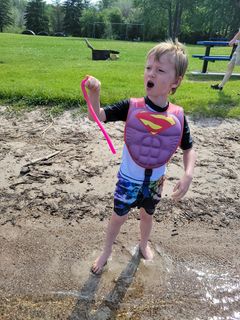 I have noticed that children are curious, and when you answer their questions, they are quite accepting, and even helpful. There is a page in Paddy’s book about how he likes to climb, and when he gets too high, we say “Danger, Paddy!” During the last three years, his peers have been very helpful in alerting the adults in the room when Paddy is climbing by repeating this phrase. I have noticed that children are curious, and when you answer their questions, they are quite accepting, and even helpful. There is a page in Paddy’s book about how he likes to climb, and when he gets too high, we say “Danger, Paddy!” During the last three years, his peers have been very helpful in alerting the adults in the room when Paddy is climbing by repeating this phrase.
This year, I will also be sending a one-pager with information that will be important to the school staff, but not necessarily his peers. As Paddy becomes older and is now entering Grade 1, I want to be protective of his feelings and ensure that his dignity is intact. I would encourage all parents of neuro-diverse children to share as much information as they can with the school team – it sure saves the team time in trying to figure out how our kids work. We are the ones who know our kids best; we are the experts.
I am proud of my children and enjoy sharing about them with others, but I used to be nervous about how that would be received. Recently, though, I was reminded about what a blessing the boys are, when after hosting a playdate for new friends, the mom wrote to me “I felt honored to meet the boys.” It was really heart-warming, and made me realize how special they really are. So, this year I will be honoured to introduce my boys to their school and others, and I hope they will feel honoured to meet them, as well.

|
|
|
Pretending to be Normal: Differences in Expression of ASD between Men and Women
A Book Review By Dr. Nicole Burnett
Did you know?
- The ratio of males to females with a diagnosis of ASD is 4:1
- Women are more likely than men to receive their diagnoses in adulthood
- Women are more like to receive a misdiagnosis of anxiety or depression
- ASD women are at increased risk of mental health problems
- The expression of ASD behaviours differs between women and men
When researching ASD, there is often very little written about sex differences in expression of ASD behaviours. But there are differences, and these differences have far-reaching implications. To understand what these  differences are, I recommend a graphic novel, Camouflage by Dr. Sarah Bargiela, which describes the differences in ASD in females when compared to males. Dr. Bargiela first discusses some of the scientific evidence for these differences, then takes us through four personal stories of women navigating their diagnoses and social journeys. The book is both informative and entertaining, accompanied by beautiful illustrations, making it easy to read. Short and sweet, I finished the book in under an hour, and was left contemplating the implications of the stigma and stereotypes for ASD women. differences are, I recommend a graphic novel, Camouflage by Dr. Sarah Bargiela, which describes the differences in ASD in females when compared to males. Dr. Bargiela first discusses some of the scientific evidence for these differences, then takes us through four personal stories of women navigating their diagnoses and social journeys. The book is both informative and entertaining, accompanied by beautiful illustrations, making it easy to read. Short and sweet, I finished the book in under an hour, and was left contemplating the implications of the stigma and stereotypes for ASD women.
From the book, here are some of the more common differences in the expression of symptoms between the sexes. First, ASD women show less repetitive behaviours compared to ASD men. Repetitive behaviours include things such as repeating specific movements (e.g. spinning objects in your hands), or insisting on the same daily routine, and a low tolerance for changes in routine. In social situations, females are better at making friends, and experience less difficulty in social communication compared to males. For example, females tend to be better at making eye contact. Both females and males dive into special interests with an intense fascination, but males are more likely to have interests that are eccentric. In one of the personal stories, the ASD woman described having an intense fascination with creative writing, and used this special interest to help navigate social interactions. Finally, ASD females often have more sensory sensitivities compared to men.
Some possible explanations for these differences are threefold. First, it is argued that women are better at masking or hiding their autism. Because women have less difficulty with social communication, they may be better at hiding their autism with ‘social mimicry’ skills, leading to an underdiagnosis of ASD women. Second, the female autism phenotype may be different from the male phenotype. This means that the definition of autism should be different between the sexes and should be diagnosed using different criteria, because  they may be genetically different. Third, females are underdiagnosed because the questionnaires used for diagnosis do not capture female autistic traits. Also, the development of these questionnaires is based on research conducted with primarily male participants, making them biased against females. they may be genetically different. Third, females are underdiagnosed because the questionnaires used for diagnosis do not capture female autistic traits. Also, the development of these questionnaires is based on research conducted with primarily male participants, making them biased against females.
Dr. Bargiela discusses several implications that I think are worth noting here. ASD has primarily been considered a “male disorder.” Women are often left out of the discussion. Yes, women are more likely to camouflage their autistic traits, but this behaviour also places women at an increased vulnerability for being taken advantage of in social situations. In one of the stories, a woman described being the victim of a sexual assault. Unfortunately, this scenario is common, and research in 2017 has indicated that camouflaging is a strong predictor of suicide in ASD women. As the author writes, “Sharing knowledge that autism even exists in females is important for challenging common biases and beliefs. This way, autistic girls and women can be safe, recognized and celebrated for their differences.”
Dr. Burnett is a cognitive scientist and is currently a psychology professor at Medicine Hat College.
|
|
|
It's As If They Think We Don't Grow Up…
Bruce Petherick
There can be no arguing with the fact that there is a lack of support for Autistics. Diagnoses can take several years to become available in the public health system, or may be expensive where private diagnosticians are available. Once a diagnosis is received, the supports are often difficult to access,  they can be hard to get to, or are only available for limited periods of time. Support for families is sparse and difficult to manage, and respite services are few and far between. they can be hard to get to, or are only available for limited periods of time. Support for families is sparse and difficult to manage, and respite services are few and far between.
Education assistance is available, but depending on where one is located, it can be difficult to receive; or, if assistance is there, it is only available in limited ways: time-limited, or limited to various periods during the day, or limited to certain days. IPP (or IEPs) are written, but often the autistic student doesn’t understand what their function is, or how to use them properly.
Government assistance can be available in the form of tax breaks or stipends, but negotiating the forms and application processes is famously difficult. When one is denied assistance, appealing the decision can be a difficult process.
And, of course, once an autistic person reaches 18, almost all these supports stop or are modified to be almost totally nonexistent.
It’s as if they think we don’t grow up…
Part of my work portfolio involved teaching musical theatre at various High Schools, usually at the Grade 10-12 level, where the students are between 15 and 18 years old. During the first class of the year, I would introduce myself and mention that I am autistic. It is important for me to act as a role model for any neurodivergent students to show them their difference is not a barrier to doing anything, or having any career that they want. I usually find that in each class of about 20-60 students, several will come up to me and tell me that they have a neurological difference. I tell them that I am always available if they need to talk about what is going on, or for pointers on how to get through situations at school, or even just to share some jokes about how weird neurotypical people are. As these kids are in senior high school, they don’t have many (or any) supports, as these tend to be concentrated in the elementary school level.
It’s as if they think we don’t grow up…
Part of my new advocacy work is to develop workshop modules for first responders, EMTs and ambulance drivers, police and firefighters. After a recent incident with the RCMP during a traffic stop with a fellow autistic in the front seat, I understood that RCMP officers were not trained to recognise autistic (or for that matter, other neurodivergent) traits in adults. I realized that we autistics also need to learn about what the police expect of us, especially concerning day-to-day interactions. I have started to develop these modules to help both sides of these interactions, and in doing my research for this, I have contacted a number of friends who are EMTs or Police. When I asked them about what sort of training they had received regarding neurodiversity and how to interact with neurodivergent people, they told me that it may have been covered for 30 minutes or an hour during their training years ago, and  that they have never received any training regarding adults. that they have never received any training regarding adults.
It’s as if they think we don’t grow up…
I don’t use functioning descriptors, as I think they are harmful. I prefer to talk about support needs, instead. I understand that, for instance, I can verbally communicate better than some autistics, and I don’t need constant support to help me with this. However, there are times when I start to get overwhelmed and do need support and accommodation. My brain cannot comprehend people's speech patterns often, and I have learned to get the gist of what people are saying, but often not the exact words. In malls and other noisy areas, I have to wear noise-cancelling headphones to survive the experiences. I do need support – just at a different level than a lot of other autistics.
We need to fight for our rights for better support systems and accommodations for all ages of autistic people. We need to engage decisionmakers, politicians, employers, educators and the general public in discourse, to raise these issues and to convince them that we need more than we have now. Every autistic person needs some level of support, and we deserve this. We need to raise our voices to share our stories and life experiences, and to stop other non-neurodivergent voices from speaking for us.
|
|
|
Imagine Van Gogh
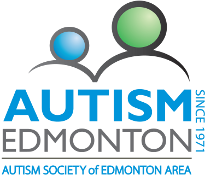
Imagine Van Gogh, the original immersive exhibition from Europe, is being hosted in the Edmonton Expo Centre. Autism Edmonton has been offered one night to show this immersive experience and raise funds for its local programs. If you've been planning to take in the Imagine van Gogh experience, please consider joining Autism Edmonton’s fundraiser on September 2!
Your $65 ticket includes a free drink, hors d'oeuvres, a charitable receipt that can be deducted from your taxes, and more!
- What: Imagine Van Gogh – In Support of Autism Edmonton
- When: Thursday, September 2, 2021 – Doors at 7 PM
- Where: Edmonton Expo Centre 7515 118 Ave NW, Edmonton, T5B 0J2
- Tickets: $65
Tickets can be purchased online.

Ticket includes:
- Welcome drink
- Exclusive entrance into the exhibit
- Cocktail reception with canapes after viewing
- Opportunity to win fantastic raffle prizes and to learn more about Autism Edmonton’s recent projects
- Access to the show gift shop, including exclusive Autism Edmonton merchandise
- Tax receipt
If you have any questions, please feel free to reach out. Also, please share the Facebook event link with your friends and family: https://fb.me/e/1GENyFQCd
|
|
|
End article-->
Things I Have Learned As An Educational Assistant
Etta Reyes
I love to learn. Whenever my parents asked me the question “What do you want to be when you grow up?” my answer would be “anything”, and by that I meant everything, because I was always curious about life. Being the daughter of a nurse, my mom was an exemplary role model for me. She used to take me with her to the small villages in our home country of Guatemala and help people, not because it was her job, but because it was her passion.
When I decided to become a teacher, my focus was how to help people read and write. How could I teach these two most important skills of life to anyone in need?
My work soon made me realize that reading and writing is about more than just words on a page, and that children can learn to read and write with pictures, too. Think about this: pictures represent words, and words convey meaning and represent a thought. Children with autism who have difficulty communicating verbally still want the same things as everyone else. They seek attention (sometimes in a negative way), especially when they feel neglected or their needs are not being met at a specific moment. It’s just like how one might verbally express frustration at the long lineup at the bank, or at the supermarket when only two of ten cashiers are open. If we get annoyed or frustrated, we can somehow control our emotions – most of the time.  But imagine how hard it could be for someone who does not have the communication skills to express these strong emotions. But imagine how hard it could be for someone who does not have the communication skills to express these strong emotions.
When a child with ASD communicates using PECs or through any AAC (Augmentative and Alternative Communication) tool or device, such as an iPad, the child is reading and writing! And this works wonders in terms of communication and self-esteem. Like anything else, learning takes time and dedication. For it to be successful, it needs to be implemented both at school and at home. That’s why it is imperative for parents to invest their time in learning how to use this communication device alongside their children. I have seen children feel such a sense of accomplishment when they are able to communicate a need or want through a device.
There are many programs out there to support communication. Asking your speech pathologist’s help in finding the one that best addresses their needs is recommended. They are part of your multidisciplinary team who support you and your child. Many parents tend to compartmentalize their team, but one cannot be proactive without cross-references. Many parents don't understand that the speech pathologist at school needs to work using the same devices or program as the speech pathologist of any other agency that may be supporting your child at home. This would save a lot of frustration for everyone involved, and there will be progress made. Sharing information between home and school is critical.
I'm passionate about working with children with autism because I don't see them for what they cannot do, but for what they can do.
Etta Reyes
Educational Assistant PKP
|
|
|
Upcoming Groups from the Society for Treatment of Autism
Click on each image to learn more
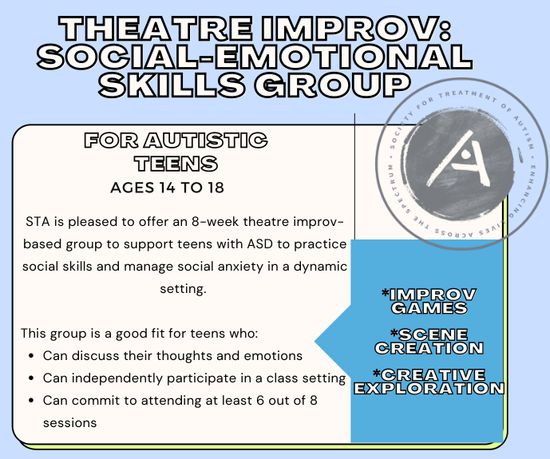
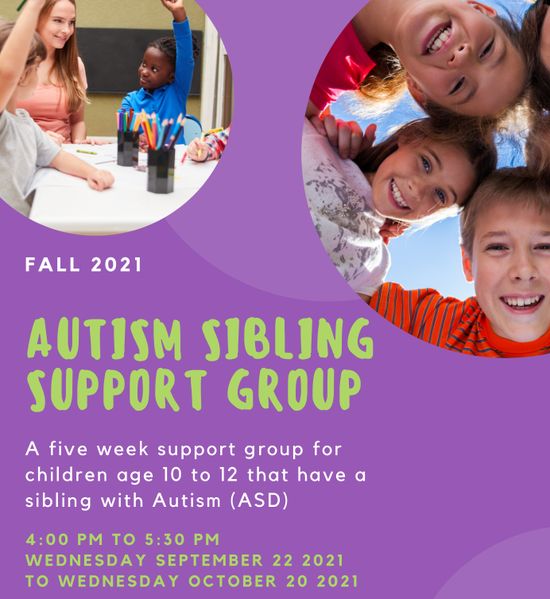
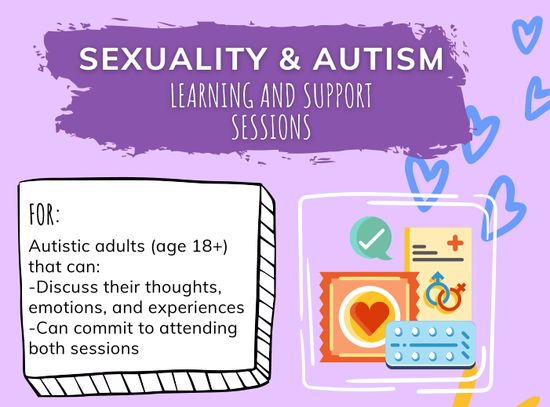
|
|
|
End article-->
The Pandemic Effects on Parent-Teacher Relationships
Maureen Bennie

From the Autism Awareness Centre Inc. Blog:
I read an interesting piece in the Globe and Mail by Bonnie Stelmach, a University of Alberta Education Professor, investigating the changes that happened with parent-teacher relations as a result of the pandemic. She drew her information from an Alberta web-based survey and from interviews with  parents and teachers. She found that there were both positives and negatives, which is good to be aware of, because this experience can provide a catalyst for awareness, change and growth. Although the study was conducted in Alberta, the findings speak to the pandemic online education experience in general. parents and teachers. She found that there were both positives and negatives, which is good to be aware of, because this experience can provide a catalyst for awareness, change and growth. Although the study was conducted in Alberta, the findings speak to the pandemic online education experience in general.
While this survey did not go into specifics for children with exceptional needs, many of the issues and findings are applicable.
Here are the highlights from the survey. You can read the article about the survey in its entirety here.
The Survey Findings
Findings from the Alberta study are based on collected data from 1,067 parent survey respondents, 566 teacher survey respondents, and 10 parents and 10 teachers who were individually interviewed.
- 45% of parents said their understanding of teacher’s demands and their respect for them increased
- 74% of teachers said they know their families better
- 43% of parents reported decreased interaction with teachers
- 18% of parents reported improvement in their relationships with teachers
In The Beginning…
When schools first closed, there was a lot of confusion. Moving classroom learning into the home brought different values and expectations to the forefront. Teachers worried about parents who weren’t communicating, and wondered why. Many parents were overwhelmed, and either minimized the time spent on school or dropped out completely. Not everyone had the technology to participate in online learning or was able supervise several children at a time. Some parents were juggling full time work and childcare, and couldn’t put the time into schooling.
Teachers weren’t sure how much to press families, particularly if they didn’t know all of their at-home circumstances. Parents were put into the teacher role and found it difficult to motivate and support their children the way teachers could. “Parents aren’t meant to be teachers,” was a common feeling among parents.
The intrusion of school into the home space caused tension. This blurring of boundaries caused some parents to give up on schooling to keep the family peace. Teachers may not have known about these trade-offs that families had to negotiate; they may have assumed apathy drove parents away.
Disappearance of Boundaries
When home and school became one, students were distracted by TV, video games, and other things they enjoyed doing at home. It was hard to maintain focus and motivation. Parents saw that teachers could motivate.  Some children wouldn’t work until they saw their teacher online. Roles became blurred as parents tried to help with learning without having the professional teacher’s role. Some children wouldn’t work until they saw their teacher online. Roles became blurred as parents tried to help with learning without having the professional teacher’s role.
Zoom was a convenient way for teachers to have timely and meaningful discussions about children’s learning and progress. It was an eye-opener for parents to sit with their children through online learning; many admitted that report card comments and discussions at parent-teacher interview now made sense. Parents don’t always know their children as students like teachers do.
The Next Phase of Normal
As we go forward into the next school year, it will be important to look at what a family values and prioritizes. While parents may value education, keeping a good family dynamic may be more important. Teachers and parents may want to discuss the parent-child or family dynamic to determine whether or how parents can play a supportive role in their children’s education. Homework may not be something parents want to deal with because of the effects it has on their family life. It doesn’t mean they are apathetic or don’t care. (We never did homework when my two children were in school, as it was too stressful for them, and they needed downtime after navigating school life all day.)
The pandemic has also given the opportunity to share progress outside of the traditional parent-teacher interviews and report cards. Online meetings may make parents feel safer and able to ask more questions, or to admit to not understanding something and seeking clarification.
 Parents do teach, but it happens in the context of daily family life (teachable moments). Doing math while cooking is positive and fun, while sitting down and working together on a math equation may not be. Parents do teach, but it happens in the context of daily family life (teachable moments). Doing math while cooking is positive and fun, while sitting down and working together on a math equation may not be.
A teacher’s authority is different from a parent’s. While parents and teachers work together to raise a child, they don’t perform the same roles. The pandemic helped us to see the value of each of these roles, and how they can work together and compliment each other. Going forward, we know so much more than we did at the beginning of the pandemic and during the introduction to online learning at home. We have gained skills, knowledge, and a better understanding of the impact that online instruction has on children and families.
|
|
|
|
|